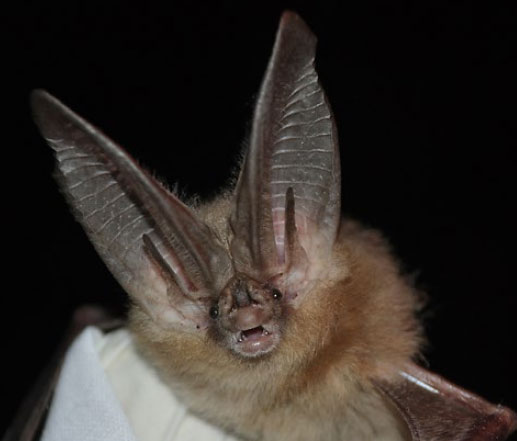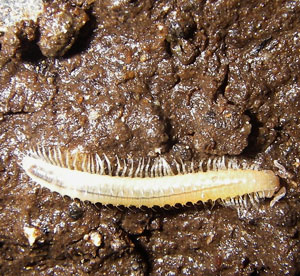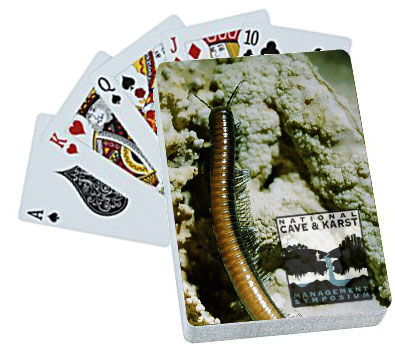

Townend's Big-eared bat (Corynorhinus townsendii pallescens.) Photo by Ann Froschauer/USFWS.
Read MoreNevada's caves are homes to a variety of animals including bats, woodrats, and a variety of invertebrates, including some that are endemic to specific mountain ranges in Nevada.
Twenty-three bat species make their home in Nevada. Many of these spend part of their time in caves. One of the biggest concentrations is at Rose Guano Cave in east-central Nevada. One to three million bats use this cave as a migratory stop from about July to September each year. Mexican free-tailed bats make up the largest concentrations. The Nevada Department of Wildlife (NDOW) conducted a multi-year tagging of bats in that cave to learn more about the migration route. Numerous caves in Nevada have seasonal closures to protect bat populations.
If you visit a cave in Nevada, you are likely to find a midden. This is a nest made of sticks, dirt, and whatever debris a woodrat has brought to it. The woodrats urinate on the midden, making it stick together. These middens are passed down from generation to generation, and some are found in the Great Basin that are thousands of years old and very useful for climate studies.
Two woodrats live in Nevada, bushy-tailed woodrat (Neotoma cinerea) and desert woodrat (Neotoma lepida). The bushy-tailed woodrat's habitat is in caves and rocky areas from pinyon-juniper to alpine areas. The desert woodrat's habitat is rocky outcrops and cliffs from arid shrublands to pinyon-juniper. Both of these species appear to be declining (Rickart et al. 2008).
Video compliments of
Great Basin National Park Foundation
The primary studies on cave invertebrates have been conducted at Great Basin National Park (Krejca and Taylor 2003, Taylor et al. 2008) and Forest Service Caves in the Schell and Snake Ranges in eastern Nevada (Gilleland 2012). These studies have encountered several millipede species that have been described as new species. Cave pseudoscorpions also appear to differentiate between ranges. Mites, springtails, flies, and spiders appear diverse. Invertebrates are more commonly seen near cave entrances and in the twilight zone, where there are more nutrients.
A study looking at the wildlife use of cave entrances in pinyon-juniper and riparian habitats found over seventeen animal species use cave entrances. The most common, in order, are mice (Peromyscus sp.), cliff chipmunks (Tamias dorsalis), humans, woodrats (Neotoma lepida), and rock squirrels (Otospermophilus variegatus). The most common times for animal movement (which triggered a remote camera to take a photo) was between six p.m. and six a.m. (Baker 2015).
Other animals occasionally seen in Nevada caves include snakes, lizards, rabbits, birds, and even mountain lions.
Keep in mind that caves are homes for all these animals, and we are fortunate to get to visit them.

Millipedes are rather rare in the desert, as they generally like cool, moist habitats. Some species have taken shelter in caves and have been isolated for so long that they have evolved into different species on different mountain ranges. Millipedes are often identified by their gonopods (genitalia) under a microscope. Within the park we just know about two cave obligate millipedes, and fortunately they look substantially different. They are both detritivores, eating detritus (decomposing plant and animal parts and organic fecal matter).

Only known from two sites in Great Basin National Park: Water Trough and Model Cave. First collected in 2006 and described as a new species in 2007. The pale coloration, size, and nearly cylindrical body distinguishes this species from others found in park caves.
Read MoreThe first cave millipede in the park was first collected in 2003 from Model Cave. It was later found in Lehman Cave--right on the edge of the trail! Amazing how it was not noticed for decades, but perhaps its extremely small size, less than 5 mm long, made it not-so-recognizable. The millipede was named Nevadesmus ophimontis, which is Latin for 'Nevada Snake Range.' A common name would thus be the "Snake Range millipede." One of the really cool things about this all-white millipede is that it is in its own new genus. That means it is substantially different from other cave millipedes (if they are somewhat similar, they are grouped with other species in the same genus and just get a new species name). For now, it is only known from a handful of caves in the South Snake Range. It is all white, having lost its pigment.
The second cave millipede in the park was first found in Water Trough Cave in 2006 and then in several of the wetter and higher elevation caves in the park. Dr. William Shear determined that it was a new species, Idagona lehmanensis, being part of the Idagona genus that is also found in Idaho and Utah and earning the species name in honor of Lehman Cave National Monument, the precursor to Great Basin National Park. Idagona lehmanensis is about 13 mm along (about three times as long as Nevadesmus ophimontis). Although it has only been found in caves in the South Snake Range, Dr. Shear thinks it hasn't been underground all that long, probably only since the latest Pleistocene climatic events forced it to find a cooler, moister habitat. It still has eyes (ocelli) and is often a yellowish or light tan color.
Pseudoscorpions are the top invertebrate predator in Lehman Cave. They are small arachnids, with eight legs. They prey on a variety of insects, including flies, beetles, larvae, and springtails (the bottom of the food pyramid in Lehman Cave).
The pseudoscorpions found in Lehman Cave have the scientific name Microcreagris grandis. They have a rather interesting history. The Lehman Cave National Monument Custodian (similar to today's superintendent) T.O. Thatcher noted and collected the pseudoscorpion in the 1930s. However, it took until the 1960s for it to be identified, when Dr. William Muchmore determined it was a new species and named it. Since then, this species has been found in other caves in the park, including alpine caves. However, it has not been found in caves on other mountain ranges, including the North Snake Range, where the Forest Service just completed an extensive bioinventory of its caves.
The pseudoscorpions in Lehman Cave are about 1/2 inch long, dark red, with little pincers. The females are lighter in color than the males. Since they have an exoskeleton, they molt as they grow, leaving behind the old shell. They may molt up to a dozen times during their lifetime.
The official event schedule for the 2025 NCKMS has now been updated. Please check our schedule page or download a PDF to your mobile device.

Great Basin National Park Foundation passionately works to enhance, preserve, and interpret the starry night skies, wide-open scenery, cultural heritage, and diverse native ecosystems of Great Basin National Park.
The Foundation is the official non-profit partner of Great Basin National Park.
![]() Partly cloudy, with a low around 20. North northwest wind 5 to 10 mph.
Partly cloudy, with a low around 20. North northwest wind 5 to 10 mph.
![]() Partly sunny. High near 47, with temperatures falling to around 40 in the afternoon. North northwest wind 5 to 10 mph.
Partly sunny. High near 47, with temperatures falling to around 40 in the afternoon. North northwest wind 5 to 10 mph.
![]() Mostly cloudy, with a low around 26. West wind 5 to 15 mph.
Mostly cloudy, with a low around 26. West wind 5 to 15 mph.

Next to the Lehman Caves Visitor Center sits the historic Rhodes Cabin. The cabin was built in the 1920s by Clarence and Bea Rhodes, who were US Forest Service custodians of Lehman Caves at the time. It is one of several cabins built to provide accommodations for visitors to Lehman Caves. Today it contains interpretive exhibits.

Troglodyte Playing Cards
We're not entirely sure what these will look like yet, but we couldn't think of hosting NCKMS in Nevada without offering some themed-out playing cards. There's a good chance the card backs will feature a cave critter of some kind, but we still have some time to figure it out.
